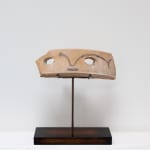

Pablo Picasso
Masque, 1950
black crayon on terracotta
21.5 x 7 cm
NFS
unique. stickers to the reverse
unique. stickers to the reverse
Copyright The Artist
Provenance
Claude Picasso has confirmed the authenticity of this workEstate of the artist
Marina Picasso (the artist’s granddaughter; acquired from the above)
By 1950 Picasso had moved from Paris to Vallauris in the South of France. In 1946, at the Madoura Pottery Workshop, run in Vallauris by Suzanne and Georges Ramié, he made an initial group of ceramics, returning the following year to revisit his works. Excited by what he saw, he realised ceramics was a medium that could synthesise sculpture, printmaking and painting. He could decorate flat plates, transform oval-shaped platters into bull rings, and paint in the round on jugs, achieving effects impossible on canvas. Manipulating wet clay, he could turn a jug into a bird and enjoy all the transformative possibilities this material offered. He was similarly enthralled by the alchemical mystery of the firing process, waiting each time to see his painting and glazing affected in ways beyond his control. Picasso also spotted the expressive potential of broken and discarded fragments, all the potter’s detritus. ‘Masque’, a unique and brilliantly simple, anthropomorphic clay sculpture, exemplifies Picasso’s ability to respond spontaneously to any object he sees and touches, however ordinary it may seem. Picking up a redundant, broken piece of pottery, he transformed two existing holes into a pair of eyes just by adding a mouth and nose, creating a face or a magical mask. In the ceramics workshop, Picasso breathed life into inert matter and constantly revelled in his limitless powers of metamorphosis.

